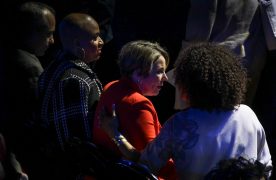The quarterback takes the snap and rolls out to his right. He sees his wide receiver about to hitch on the cornerback. The quarterback pauses, waiting for the go. The wideout is free, streaking toward six points. The quarterback cocks his arm and fires. For a split second, he sees the football wobble in front of his face, then he’s breathing Astroturf.
What happened? There was no left tackle to protect his weakside.
Just how a quarterback is nothing without someone watching his weakside, assistant coaches are the oil that keeps the coaching engine running. On a 12-man basketball roster or a 17-woman softball squad, no coach can monitor the personalities and performances of each player for an entire season. And the more they are asked to micromanage — not to mention handle recruiting and purchasing equipment — the less they can concentrate on the most heralded aspect of sports: winning.
That’s where those other guys on the sideline come in.
So, where do the Boston University assistants come from — California, Harvard, the Atlantic Coast Conference? Yes. But more so than any other place, assistant coaches, like first-year men’s basketball assistant Lamar Reddicks or second-year softball assistant Jen Deering, come from the game itself.
Reddicks, 29, who spent seven years as an assistant at Harvard University after spending four years playing power forward at Bentley College, had the luxury of choosing a career at an age when most kids haven’t even chosen whether to put dice or an air freshener in the rearview mirror.
“Even since high school I knew I wanted to coach,” Reddicks said. “I had great teachers when I was in high school. My coach was like a father figure to me. They had a positive impact on my life. One of the reasons I coach is to return that positive impact.”
But for Deering — a 2002 national champion at University of California-Berkeley and former head coach of Piedmont High School in Piedmont, Calif. — it took a few cautious toes in the shallow end before arriving at the same splash into coaching as Reddicks.
“I didn’t think that I would get into coaching too much [after graduating],” Deering said. “I figured I’d do some stuff on the side. I started coaching a youth team in California and I just fell in love with it. I found myself looking forward to it every week. I ended up coaching a high school team. I was like, ‘If I could make this my career, that’d be great.'”
But back to where they came from, or, more importantly, where they were found. Do a survey around the world and you’ll likely find that nearly every coach outside of Catholic youth leagues has played their sport at a higher level. BU men’s soccer coach Neil Roberts knows this, and at all times has in the back of his head a list of players who he thinks would be a good addition to his staff.
“I like to try and get guys that I’ve coached at other places,” Roberts said. “That way you know the personality of the person. I don’t think that list is ever not there.”
For Roberts, his assistants, one of whom is a volunteer, are people who have a talent he can help develop as much as he does his defensive backs and strikers. Because, while the future is foggier for Deering, there are many coaches like Reddicks who someday see themselves as the figurehead of a program.
“My philosophy is you can’t just have them out there putting out cones,” Roberts said. “You hire guys because they’re good and because they’re capable of being good so you have got to give them the opportunity to coach.”
When you’re coaching a mid-major Division I school it can be tough to hold onto quality hirings because it’s never long before the top dogs come calling. For softball head coach Shawn Rychcik, who two seasons ago lost top assistant Jocelyn Forest to Penn State University, it comes down to a rotating set of new references of potential coaches whom he prefers have experience and success.
“[Jen Deering] had to learn me just as new players had to learn me,” Rychcik said. “You want to stay within your philosophies as a coach. If you’re quiet and let the kids be responsible on their own, you don’t want to bring in someone who is going to crack the whip. Because then you’ve got one coach yelling at you and one coach patting your back and they’ve got no idea which way they’re coming and going.”
But Rychcik doesn’t look exclusively for coaches with inflated win columns at the lower levels, because they might have had a player so talented they put the coach on a sort of career cruise control. Sometimes, he says, the best coaches are the ones who had to work their way up from the bottom and are forced to try every technique available.
Once assistants like Deering and Reddicks get that call from a head coach, they’ve got to find their role. Many professional assistants fall into the categories of player’s coaches or X’s and O’s personnel, but Rychcik’s philosophy does not include delegating all player relations to assistants. He prefers balance. Which means Deering’s role includes being a pitching and first base coach — and earning her graduate degree — while acting as a liaison between the players and Rychcik.
Though a hands-on coaching approach is good, when assistants and players are close in age, the walk the thin line between boss and buddy.
“There’s definitely a balance. I coached a college team in California right after I graduated,” Deering said. “The girls were literally a year younger than me — I had played against most of them — and so it was a big struggle. It was hard not to just be their friend.
“Over the years I’ve definitely developed a pretty good balance of being someone they can feel comfortable with – because I’m not that much older than them – but also someone that they respect and that can push them and get on them about things.”
But no matter how well some do things, what’s forgotten, says Roberts, is that only 20 percent of coaching happens during the games. The rest is all the other stuff. If you don’t realize that, says Rychcik, you run the risk of burning out early.
But those risks pale in comparison to moments when assistants like Deering and Reddicks, taking players under the proverbial wing, see the culmination of their playing and coaching career pay off.
“My first year [at Harvard] I was dealing with this kid, a 7-foot player, so they take a little longer to get things,” Reddicks said. “We were working on this one move for a long, long time. He finally did it in the game and the kid ran back down the court and just smiled at me ear to ear. And I said to myself at the time, ‘That’s why I coach basketball.’
“It was just an up-and-under move, but if you could have saw his face and saw him run back on defense . . . it was priceless. I don’t even know what the time or the score was, but that vision is in my head all the time,” he continued.
So, the next time you see a quarterback being protected by a young left tackle not get sacked, look over at the sidelines. You’ll probably be able to locate the offensive-line coach just by the smile on his face. Just don’t ask him for the time remaining.
This is an account occasionally used by the Daily Free Press editors to post archived posts from previous iterations of the site or otherwise for special circumstance publications. See authorship info on the byline at the top of the page.












